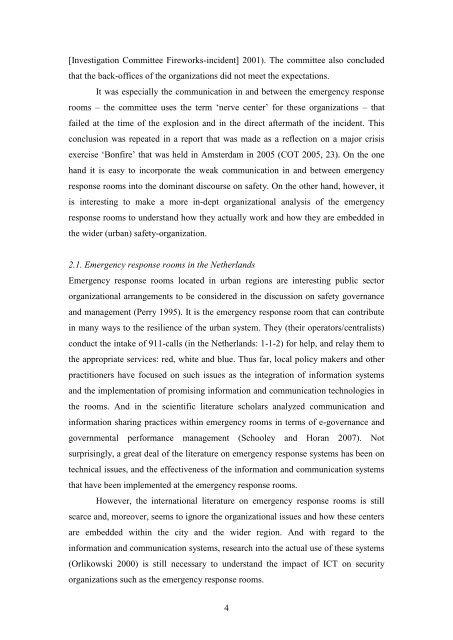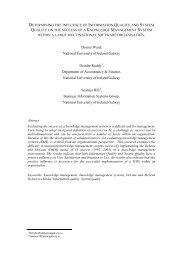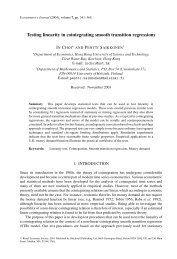Kees Boersma; Peter Groenewegen
Kees Boersma; Peter Groenewegen
Kees Boersma; Peter Groenewegen
You also want an ePaper? Increase the reach of your titles
YUMPU automatically turns print PDFs into web optimized ePapers that Google loves.
[Investigation Committee Fireworks-incident] 2001). The committee also concluded<br />
that the back-offices of the organizations did not meet the expectations.<br />
It was especially the communication in and between the emergency response<br />
rooms – the committee uses the term „nerve center‟ for these organizations – that<br />
failed at the time of the explosion and in the direct aftermath of the incident. This<br />
conclusion was repeated in a report that was made as a reflection on a major crisis<br />
exercise „Bonfire‟ that was held in Amsterdam in 2005 (COT 2005, 23). On the one<br />
hand it is easy to incorporate the weak communication in and between emergency<br />
response rooms into the dominant discourse on safety. On the other hand, however, it<br />
is interesting to make a more in-dept organizational analysis of the emergency<br />
response rooms to understand how they actually work and how they are embedded in<br />
the wider (urban) safety-organization.<br />
2.1. Emergency response rooms in the Netherlands<br />
Emergency response rooms located in urban regions are interesting public sector<br />
organizational arrangements to be considered in the discussion on safety governance<br />
and management (Perry 1995). It is the emergency response room that can contribute<br />
in many ways to the resilience of the urban system. They (their operators/centralists)<br />
conduct the intake of 911-calls (in the Netherlands: 1-1-2) for help, and relay them to<br />
the appropriate services: red, white and blue. Thus far, local policy makers and other<br />
practitioners have focused on such issues as the integration of information systems<br />
and the implementation of promising information and communication technologies in<br />
the rooms. And in the scientific literature scholars analyzed communication and<br />
information sharing practices within emergency rooms in terms of e-governance and<br />
governmental performance management (Schooley and Horan 2007). Not<br />
surprisingly, a great deal of the literature on emergency response systems has been on<br />
technical issues, and the effectiveness of the information and communication systems<br />
that have been implemented at the emergency response rooms.<br />
However, the international literature on emergency response rooms is still<br />
scarce and, moreover, seems to ignore the organizational issues and how these centers<br />
are embedded within the city and the wider region. And with regard to the<br />
information and communication systems, research into the actual use of these systems<br />
(Orlikowski 2000) is still necessary to understand the impact of ICT on security<br />
organizations such as the emergency response rooms.<br />
4
















